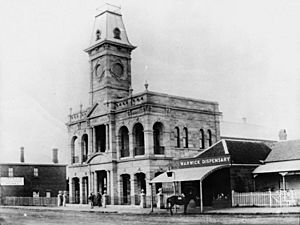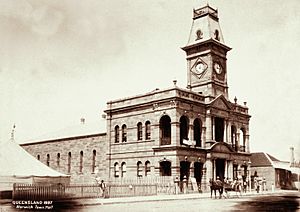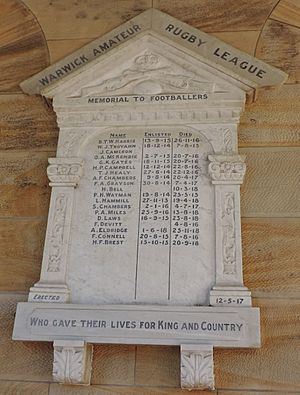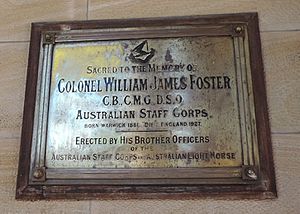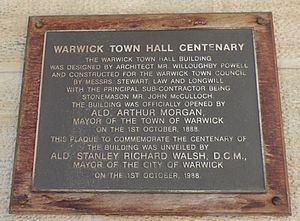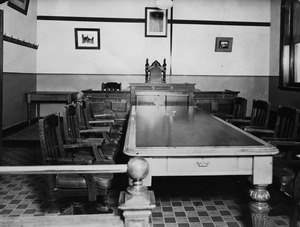Warwick Town Hall facts for kids
Quick facts for kids Warwick Town Hall |
|
|---|---|

Warwick Town Hall, 2020
|
|
| Location | 72 Palmerin Street, Warwick, Southern Downs Region, Queensland, Australia |
| Design period | 1870s - 1890s (late 19th century) |
| Built | 1887 - 1917 |
| Official name: Town Hall and Footballers Memorial | |
| Type | state heritage (built) |
| Designated | 21 October 1992 |
| Reference no. | 600961 |
| Significant period | 1880s-1890s; 1910s (fabric) 1887-1975 (historicall) 1888 - ongoing (social) |
| Significant components | tower - clock |
| Lua error in Module:Location_map at line 420: attempt to index field 'wikibase' (a nil value). | |
The Warwick Town Hall is a special old building in Warwick, Australia. It is located at 72 Palmerin Street. This building was constructed between 1887 and 1917. It is also known as the Footballers Memorial. The Warwick Town Hall is listed on the Queensland Heritage Register because of its historical importance. It was added to the list on October 21, 1992.
Contents
Discovering Warwick Town Hall's Past
The Warwick Town Hall officially opened on October 1, 1888. The Mayor of Warwick, Arthur Morgan, opened it. This sandstone building shows how Warwick grew into an important business and government center in the late 1800s.
Warwick started growing slowly in the 1850s. By 1857, about 1,300 people lived there. A law in 1858 said that towns with over 1,000 people could ask to become a municipality. This meant they could have their own local government.
In 1859, Queensland became a separate colony from New South Wales. Warwick was already a major town on the Darling Downs. It even had its own representative in the government.
In 1861, people in Warwick asked the Governor of Queensland to make their town a municipality. On May 25, 1861, Warwick became a municipality. It was the fifth town in Queensland to get this status, after Ipswich, Toowoomba, Rockhampton, and Maryborough. The first local election was held on July 5, 1861. John James Kingsford became Warwick's first mayor.
Early Town Hall Buildings
The first Warwick Town Hall was in a simple wooden building. It was originally Warwick's first Court House, built in the early 1850s. In 1873, the Council bought a brick building called the Masonic Hall. This building on Palmerin Street served as the Town Hall until the new, grander one was built in 1887.
Designing the New Town Hall
In 1885, a competition was held to design the new Town Hall. The Council wanted to spend no more than £3,500. The first prize went to Clark Bros, but their design was not chosen. Instead, the Council picked the design by Willoughby Powell, even though it was more expensive.
Willoughby Powell was an architect who worked in Queensland from about 1873 to 1913. He designed many important buildings. These included churches, homes, shops, hotels, and the Toowoomba Grammar School. He also designed the Toowoomba City Hall.
Building the Town Hall
The Council asked for bids to build the Town Hall in 1887. They chose Michael O'Brian to build it from stone. But soon after starting, O'Brian had financial problems. The company Stewart, Law and Longwill took over the work.
The stone work was done by John McCulloch, a local stonemason. He also worked on other famous buildings in Warwick. These include Pringle Cottage, the Warwick Court House, and St Mark's Anglican Church.
The foundation stone for the new Town Hall was laid in August 1887. Lady Griffith, the wife of the Premier of Queensland, Sir Samuel Walker Griffith, did the honors. A special bottle with a scroll, local newspapers, and coins was placed inside the stone.
Adding the Clock Tower
The original design by Willoughby Powell did not include a clock tower. But in late 1887, people suggested adding one. In December 1887, citizens voted to add a tower. The clock itself was put in around 1892. It is believed that the Council bought a bell from St Mary's Church in Warwick for the tower.
The Council started using the new Town Hall in September 1888. Mayor Arthur Morgan officially opened it in October. The event included a concert. Morgan said the new Town Hall was "a credit to the town."
Gas lighting was put in the building in 1889. This was later replaced by electricity around 1912.
Remembering Heroes: The Footballers Memorial
In 1917, a group led by James Brown wanted to honor local rugby football players. These players had died serving their country in World War I. A committee was formed, and money was collected. A special stone tablet was unveiled in May 1917.
This tablet has names carved on it and is placed at the entrance of the Town Hall. Local stonemasons Troyahn, Coulter and Thompson made it. At the unveiling, Mayor Ald. Gilham said that playing football helped prepare young men for service. He compared it to how cricket fields in England might have helped win battles.
Another memorial is also at the Town Hall entrance. It is a plaque for Colonel William James Foster. He was born in Warwick in 1881 and died in England in 1927. His fellow officers put up this memorial.
Warwick Becomes a City
In October 1935, Warwick celebrated 75 years of local government. People started talking about Warwick becoming a city. On April 2, 1936, the Queensland government officially made Warwick a city. This was celebrated on June 29.
By the late 1960s, the Town Hall was considered too small for the City Council. A new administration building was built. The last Council meeting in the old Town Hall was in August 1975.
The hall got a new roof in 1975. Its outer walls were cleaned in 1978. The entrance area and inside of the hall have also been updated.
On October 1, 1988, the Town Hall celebrated its 100th birthday. A plaque was unveiled by Mayor Stanley Richard Walsh. Trees were also planted in Apex Park to mark the occasion.
In 1994, the Queensland Government combined the City of Warwick with nearby areas. This created the Shire of Warwick.
Today, the former Council offices in the Town Hall are used by the Warwick Education Centre. The Town Hall is still used for community events. These include flower shows, school plays, and other fun activities.
Exploring the Town Hall's Design
The Warwick Town Hall is a two-story building made of sandstone. It has a classic design. The front of the building, facing Palmerin Street, is very grand and balanced. It has covered porches with columns on both levels. The middle part of the building has a tall clock tower.
The stone blocks are carefully cut and fitted together. The main entrance has columns and flat columns (pilasters) with fancy tops. There's a curved top section (pediment) with a shield design. The upper part of this section has similar columns and a pointed top section with "1888" carved in the middle. "TOWN HALL" is written above the entrance.
On each side of the central entrance, there are arched walkways on the lower level. The upper level has a porch with rounded arches and iron railings. Above this is a decorative edge (cornice) and a stone wall (parapet) with round openings and urns on top.
The clock tower is square. It has flat columns at its corners and a clock face on all four sides. The roof of the tower is steep and made of corrugated iron. It has vents, decorative iron work, and a flagpole at the very top.
The lower porch has a concrete floor. It has tall windows with rounded tops. Inside this porch, there are arches that lead to a small entrance area. The Footballers Memorial is on the wall here.
The sides of the building are simpler than the front. They have similar windows and stone details. The main hall part of the building is even simpler. It has tall windows and a gabled roof made of corrugated iron. The back of the building has a wooden extension for backstage areas.
Inside the Town Hall
You enter the building through large wooden doors. The entrance hall has several wooden doors leading to offices. There's also a fancy plaster archway leading to the cedar staircase. This staircase has carved newel posts and balusters.
At the top of the stairs, there are more doorways to offices. These used to be the "Mayor's Room," the "Council Chambers," and the "Town Clerk's" office. You can still see the painted signs on the doors. Another smaller staircase goes up into the clock tower.
The old Council Chamber has glass doors leading to the porch. It also has a carved wooden fireplace. These rooms have wooden ceilings with decorative plaster roses.
Beyond the stairs, there's a foyer leading to the main hall. The hall is a long, rectangular room with a stage at one end. Tall, narrow windows line the walls. The ceiling has a pattern of square sections (coffers) with decorative metal roses.
There is a balcony (gallery) at the western end of the hall, above the entrance foyer. This balcony has an iron railing and decorative metal trim. From the stage, you can see the large wooden roof supports (trusses).
Behind the stage is a single-story wooden extension. This area has backstage rooms, changing rooms, a meeting room, and a kitchen. Some parts of these rooms have wooden decorations that make them look a bit like old English Tudor style.
The Footballers Memorial
On the front wall outside the hall, there is a marble plaque. This is the Warwick Amateur Rugby League War Memorial to Footballers. It lists nineteen footballers who died during the First World War.
It is a beautiful honor board with classic designs and lead letters. It has carvings of leaves and other decorations. The bottom is supported by two carved brackets. Flat columns with fancy tops frame the list of names. At the very top, there is a triangular section with crossed rifles, a football, and a crown.
Why Warwick Town Hall is Special
The Warwick Town Hall and the Footballers Memorial are important heritage sites. They are listed on the Queensland Heritage Register because they meet several special criteria.
- Shows Queensland's History: This sandstone building, opened in 1888, shows how Warwick grew into an important business and government center in the late 1800s.
- Rare and Unique: The Town Hall is one of the few old town halls in Queensland that is still mostly in its original condition. The Footballers Memorial is also unusual. It connects war and sport, and it's a unique record of local people who fought in World War I.
- Great Example of its Type: Inside, the building still has much of its original layout and wooden features. You can see how the different offices and functions were set up. The memorial plaque shows excellent craftsmanship by local stonemasons.
- Beautiful to Look At: This large stone building stands out on Palmerin Street. It adds a lot to the beauty of Warwick's town center.
- Important to the Community: The building has always been a central place for the Warwick community. It is still used for social events and gatherings.
- Connected to Important People: The Warwick Town Hall is linked to the architect Willoughby Powell. He designed many important public buildings in Queensland during the late 1800s and early 1900s.


